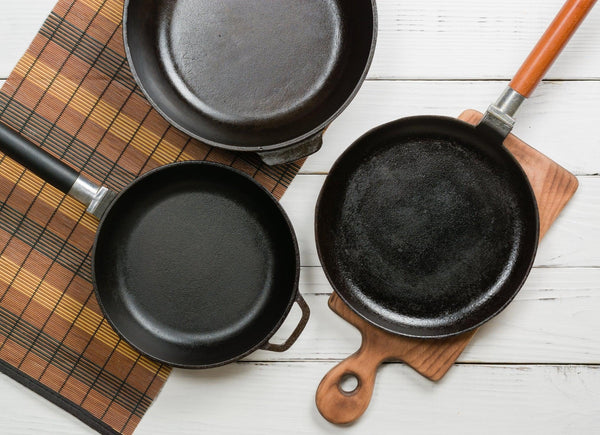
Jump to:
Japanese kitchenware, renowned for its craftsmanship and durability, is often made out of quality materials including iron and cast iron. While these materials undoubtedly elevate cooking and dining experiences, properly caring for them requires a bit of backhand knowledge. This guide will teach you how to properly care for your Japanese iron and cast iron kitchenware so that you can continue to enjoy using it for years to come.
Ironware
Iron is a popular material used for crafting Japanese kitchenware items. It’s praised for its durability and ability to hold heat. Among all of the Japanese kitchenware brands, Ikenaga Iron Works in particular, undoubtedly stands out for their beautiful ironware products.
If you purchase any ironware from Ikenaga (or any ironware in general), here is some important information you should keep in mind to keep your ironware lasting for years to come.
How To Care For Iron Kettles
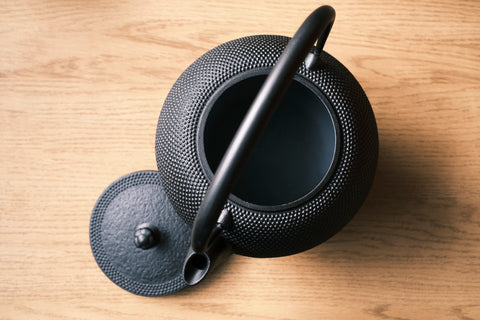
- Give the inside of the iron kettle a gentle rinse with water (avoid scrubbing with a sponge or abrasive cleaner). No need to use any soap or cleaning detergent.
- Boil some water, and dispose of it (repeat 2-3 times).
- Now, it's ready for use. Please reserve the iron kettle exclusively for boiling water.
Note: Boiling tea leaves may lead to a reaction between the tannins in the leaves and the iron, resulting in the tea turning black. Therefore, it is not recommended to do this. Furthermore, avoid boiling tea leaves, as it can lead to the leaves and odors adhering to the interior of the iron kettle and causing mold.
In the case of rust forming:
- Boiling hot water in a rusty iron kettle isn't harmful to your health, so feel free to use it as it is.
- If you're worried about rust or a metallic taste, a helpful tip is to place your tea leaves in a tea bag and boil them together. Do this 2 to 3 times.
- Afterward, boil water by itself 2-3 times until the water runs clear.
Note: Be aware that rust is more likely to accumulate on the spout and the back of the lid. You can tackle this by gently scrubbing those areas with a cloth soaked in tea.
If the inside of the kettle turns white:
- Chlorine and limescale are present in tap water and become eliminated when boiled in iron kettles, and they often leave behind a white residue known as scale.
- This white residue is known as a hot water scale, and it functions as a rust inhibitor and contributes to the distinctive mellow flavor of the hot water, enhancing the overall taste of your tea.
- Maintaining this hot water scale is essential for ensuring the long-term durability and performance of your iron kettle.
How To Care For Iron Pots
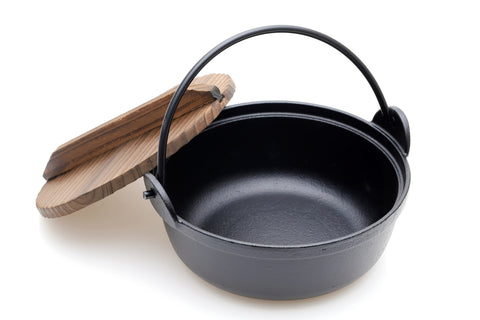
- Clean with warm or hot water using a gentle sponge.
Note: Avoid using soap/cleaning detergent, as it can seep into the crevices of the iron surface and become challenging to remove.
How To Care For Iron Woks
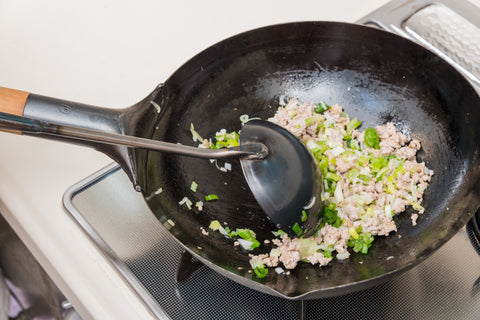
When it comes to caring for Iron Woks, there are a few steps that you should keep in mind:
Seasoning the Wok
You'll need to season your wok before use. Wash the wok with hot, soapy water to remove any factory residues. Rinse thoroughly and dry it completely.
Heat the wok over medium-high heat and add a high smoke-point oil, like vegetable or canola oil.
Swirl the oil around to coat the entire surface, including the sides. Allow it to heat until it starts smoking. Then, discard the oil and wipe the wok with a paper towel. This process creates a non-stick surface and prevents rust.
Cleaning the Wok
- After cooking, rinse the wok with hot water and use a soft brush or sponge to remove any food particles. Avoid using abrasive materials that can damage the seasoning. Do not use soap, as it can strip the seasoning. If necessary, you can boil water in the wok to loosen stuck-on food.
- Dry the wok thoroughly after cleaning.
Reseasoning the Wok, as needed
- Over time, the seasoning on your wok may wear off. You can re-season it by repeating the initial seasoning process.
Storing the Wok
- Store your wok in a dry place to prevent rust.
- You can place a paper towel or cloth inside the wok to absorb any moisture.
Remember not to use strong detergents, abrasive scrubbers, or dishwashers on your iron wok, as they can damage the seasoning and the wok's surface.
How To Care For Iron Plates & Pans

- Clean using a soft sponge and water; avoid using soap/cleaning detergent to prevent it from penetrating the textured iron surface, which can be challenging to remove.
- Following this, lightly sauté vegetables or other items in the plate or pan. This will help reduce any lingering paint odor and promote better oil absorption into your iron plate or pan.
- Dispose of the sautéed vegetables, wash the plate or pan with water, thoroughly dry, and then apply a thin layer of cooking oil, excluding areas directly exposed to flames.
Note: This oil will season the pan, and help to protect it from rust while acting as a safe, natural non-stick coating.
In the case of rust forming (applies to iron pots, plates, & pans):
- Use a sponge to remove the rust.
- Next, rinse it with water, allow it to dry, and finally, apply a light coating of cooking oil to the affected area.
Products That Help With Taking Care Of Iron
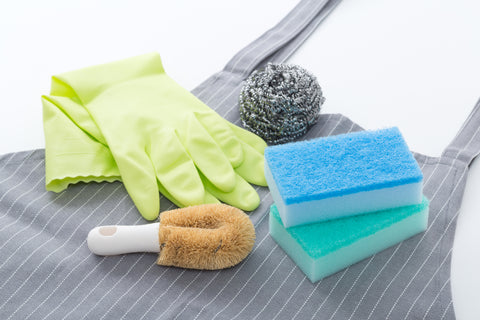
We also have some products available on our website that will help you take extra good care of your iron kitchenware.
- Kamenoko Tawashi Scrubber Hemp Palm Scrubbing Brush: the Tawashi stands out as a versatile and robust cleaning tool specially designed for iron cookware. Its exceptional blend of flexibility and hardness makes it ideal for maintaining the pristine condition of your cast iron skillets, griddles, and other iron cookware pieces.
- Bamboo Cleaning Whisk Pot Scrubber: This whisk is specifically designed for cleaning scorches on the surfaces of iron pans, pots, and woks. This bamboo whisk efficiently removes dirt while maintaining the essential iron properties.
How To Care For Iron Balls

Given that iron balls (like the kitty chan iron ball) are constructed from iron, when they come into contact with water, they will inevitably undergo rusting, even if you diligently cleanse and fully dry them. However, there's no need to be concerned! Consuming the rust that develops on iron balls does not pose any health risks.
Can Iron Products Be Used Over Electric Or Induction Stoves?
Yes, iron is compatible with both electric and induction stoves. However, it is important to pay close attention to the shape of your iron product. If your iron product has a flat bottom, then it will fit perfectly on both electric and IH burners. However, if it has a rounded bottom, then it will be difficult if not, impossible to use over an electric or IH burner.
Additional Notes About Cast Iron
Cast iron products can release iron under certain conditions. Consequently, if they are stored in a damp environment or with food residues, they are prone to rust. Therefore, it is highly recommended to dry your iron products as thoroughly as possible after use.
By following these simple care instructions, you can enjoy your iron and cast iron cookware for many delicious meals and years to come.
Please note that in order to provide the most accurate information in this article, all of the information and tips provided have been provided directly by the manufacturers of iron and cast iron that we carry in our store.
Want to learn how to take care of other kinds of Japanese kitchenware? Check out our articles on caring for copper and stainless steel kitchenware, and this guide for knives.


0 comments